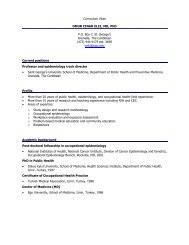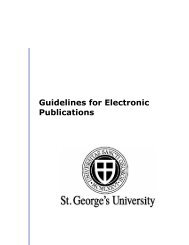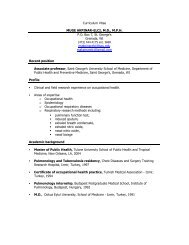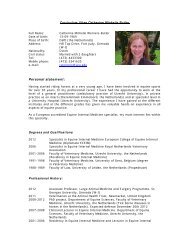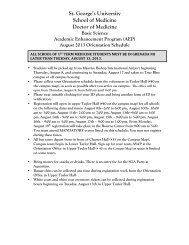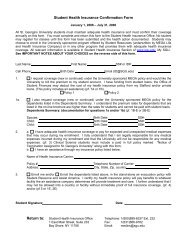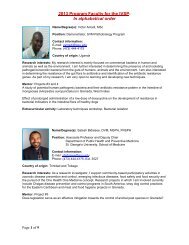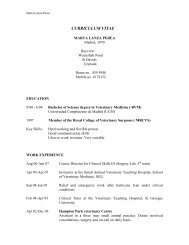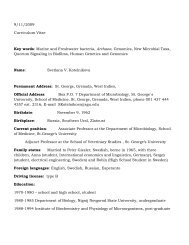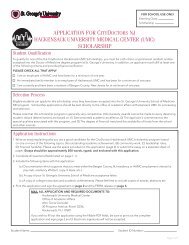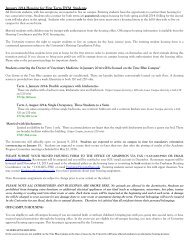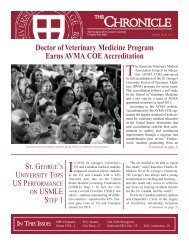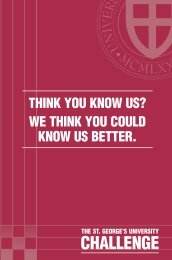SCHOOL OF 2012-2013 - St. George's University
SCHOOL OF 2012-2013 - St. George's University
SCHOOL OF 2012-2013 - St. George's University
Create successful ePaper yourself
Turn your PDF publications into a flip-book with our unique Google optimized e-Paper software.
Internal Medicine<br />
John Sensakovic, MD, PhD, Chair<br />
The 12 weeks of the internal medicine rotation are designed<br />
to expose students to a wide variety of medical problems.<br />
<strong>St</strong>udents are expected to develop a logical approach to the<br />
diagnosis and treatment of patients’ complaints. Some of<br />
the skills that must be acquired and refined are how to elicit<br />
and assess patient information, how to perform a complete<br />
and accurate physical examination, how to formulate a<br />
differential diagnosis and problem list, how to construct a<br />
diagnostic workup and a plan of management, and how to<br />
write up and present cases.<br />
<strong>St</strong>udents thoroughly study at least two new patients per<br />
week, present them on teaching rounds, follow them<br />
throughout their hospital stay, and use patient problems as<br />
a basis for reading.<br />
The end of the rotation should accumulate large amounts<br />
of experience-based knowledge as students are assigned<br />
cases in various major areas of medicine such as cardiology,<br />
gastroenterology, and endocrinology. Self-learning<br />
techniques, as well as compulsory attendance at lectures,<br />
conferences, and teaching rounds, in concert with a careful<br />
study of patients, should foster a sound pathophysiological<br />
approach to medical diseases and a concern for and<br />
awareness of patient needs.<br />
Surgery<br />
James Rucinski, MD, Interim Chair<br />
The goal of the surgery rotation is to acquaint students<br />
with those clinical problems that require surgery as part<br />
of the therapeutic management. The emphasis of this<br />
rotation is not primarily on surgical technique, but on the<br />
understanding of the pathophysiology of surgical disease,<br />
as well as on the management of pre-operative and postoperative<br />
therapy. Besides the many short histories and<br />
physical examinations done during this rotation, students<br />
are required to perform detailed histories and physical<br />
examinations on at least two patients admitted to the<br />
surgical service each week, and to follow these patients<br />
through surgical and post-operative therapy.<br />
Attendance in the operating room is required when surgery<br />
is performed on a patient for whom students obtained an<br />
admission history and performed a physical examination.<br />
<strong>St</strong>udents must assist in the operating room to gain an<br />
understanding of basic surgical techniques, surgical<br />
discipline in relation to asepsis, and care of the unconscious<br />
patient. The more common post-operative complications<br />
must be recognized. <strong>St</strong>udent follow-ups of patients are<br />
required (for example, pathology, radiology, rehabilitation<br />
medicine). Procedures that involve manual skills, such as<br />
venipuncture, placing and removing sutures, and urethral<br />
catheterization are incorporated into the surgical rotation.<br />
Initially, students are under direct supervision. After<br />
demonstrating proficiency, they are indirectly supervised.<br />
Obstetrics/Gynecology<br />
Paul Kastell, MD, Interim Chair<br />
The goals of the clinical rotation in obstetrics/gynecology<br />
are to provide students with knowledge and experience<br />
in managing the normal and abnormal changes that occur<br />
during pregnancy, labor, delivery, and the puerperium,<br />
and in diagnosing and treating gynecological disorders.<br />
<strong>St</strong>udents become proficient in taking histories from and<br />
examining such patients, learning to perform pelvic<br />
examinations, including how to pass a speculum and obtain<br />
a cervical smear, as well as in attending to their patients<br />
in the operating and delivery rooms. Additional student<br />
experiences include the observation of labor, delivery of<br />
cases, installation of intravenous infusions, recording of<br />
partograms, helping with problems of anesthesia, and<br />
attendance at special clinics such as pre- and post-natal<br />
care, family planning, infertility, and high-risk cases.<br />
<strong>St</strong>udents attend conferences, lectures, and teaching<br />
rounds. They are expected to follow their patients carefully,<br />
read textbooks and literature referable to their patients’<br />
problems, and pay special attention to public health<br />
aspects of reproductive medicine, especially as they relate<br />
to maternal and perinatal morbidity and mortality, sexually<br />
transmitted disease, cancer detection, and human sexuality.<br />
Psychiatry<br />
Amy Hoffman, MD, Chair<br />
The purpose of the rotation is to convey psychiatric<br />
concepts, attitudes, and skills that are needed by all students,<br />
regardless of their future career plans. By the conclusion of<br />
the rotation, students should be able to elicit, organize, and<br />
present a full psychiatric history, perform a mental status<br />
examination and a differential diagnosis, and suggest<br />
methods of treatment. <strong>St</strong>udents will have improved their<br />
ability to establish a physician-patient relationship and will<br />
have acquired knowledge of psychological factors in physical<br />
illness. <strong>St</strong>udents will demonstrate improved interviewing<br />
skills and know the major indications, uses, and side effects<br />
School of Medicine<br />
Course Descriptions<br />
School of Medicine Catalog <strong>2013</strong>–2014 | 75



